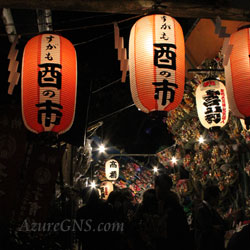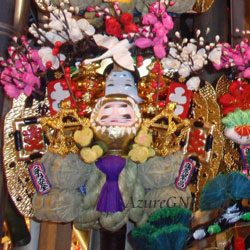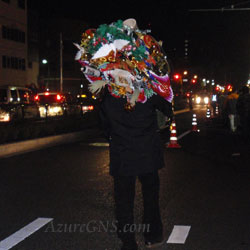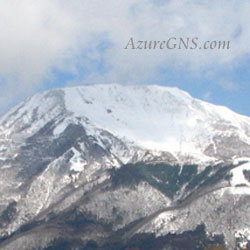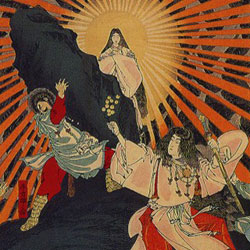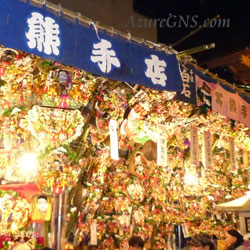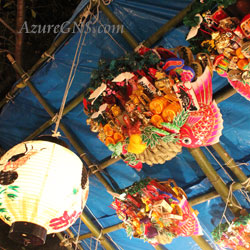(11月の酉の日)
Tori-no-ichi;
The Rooster Festival
(Tori-no-hi in November)
●酉の市 Torino-ichi Festival;
●酉 a rooster
●十二支 the twelve signs of the Chinese zodiac
●神社 a shrine
●寺 a temple
●境内 precincts
●参道 an approach to a shrine; an approach to a temple
●商売繁盛 the prosperous business; the prosperity of one’s business
●家内安全 the safety of one’s family; the well-being of one’s family
●縁起熊手 Engi-kumade; a lucky rake
●打ちでの小槌 a lucky mallet
●招き猫 a lucky-beckoning cat
●小判 an old Japanese gold coin
●鶴 a crane
●亀 a turtle
●手締め Tejime; a united ceremonial hand-clapping performance
●収穫祭 a harvest testival
●露店 a (street) stall
◆中国伝来の伝統的な考え方から、旧暦では年、月、日、時を十二支で表します。
In the lunar calendar, Juni-shi, the twelve signs of the Chinese zodiac, are used to designate years, months, days and time based on a traditional Chinese idea.
◆十二支は子(鼠)、丑(牛)、寅(虎)、卯(兎)、辰(竜)、巳(蛇)、午(馬)、未(羊)、申(猿)、酉(鳥)、戌(犬)、亥(猪)です。
The Juni-shi signs are Ne (Rat), Ushi (Ox), Tora (Tiger), U (Rabbit), Tatsu (Dragon), Mi (Snake), Uma (Horse), Hitsuji (Sheep), Saru (Monkey), Tori (Rooster), Inu (Dog) and I (Wild Boar).
◆それぞれの日は12日ごとに回ってきますので、同じ十二支の日が1ヶ月に2回ないし3回あります。
Since each day comes once every 12 days, days with the same Juni-shi sign come two or three times a year.
◆毎年11月の酉の日の酉の刻(午後5時から7時)に、主に関東の大鳥神社(または鷲神社、大鷲神社とも書きます)で酉の市、又はお酉様(おとりさま)や酉の祭(とりのまつり)と呼ばれる祭礼が開かれます。
The festivals called Tori-no-ichi, Otori-sama or Tori-no-matsuri (the Rooster Festival) are held at Tori-no-koku (a rooster time: from 5:00 p.m. to 7:00 p.m.) at Otori Shrines mainly in the Kanto area on Tori-no-hi (a rooster day) in November of every year.
◆最初の酉の市は「一の酉」、二番目は「二の酉」、そして三番目は「三の酉」と呼ばれます。
The first Tori-no-ichi is called “Ichi-no-tori”, the second is called “Ni-no-tori”, and the third is called “San-no-tori”.
◆三の酉まである年は火事が多いという俗説があります。
According to a common saying, fires break out more during the year in which the San-no-tori Festival is held.
◆東京三大酉の市は台東区の鷲神社(おおとりじんじゃ)、新宿区の花園神社、調布市の大國魂(おおくにたま)神社で開かれます。
The three greatest Tori-no-ichi in Tokyo are held in Otori Shrine located in Taito Ward, Hanazono Shrine in Shinjuku Ward and Okunitama Shrine in Chofu City.
◆神社だけでなく、寺の中でも酉の市が行われるところがあり、東京都台東区の長國寺は酉の寺とも呼ばれ、浅草酉の市発祥の地です。
Tori-no-ichi are held in temples as well as shrines such as the Chokoku-ji Temple in Taito Ward, Tokyo which is the birthplace of Asakusa Tori-no-ichi.
◆寺社の境内には縁起物の「縁起熊手」を売る露天がずらりと並びます。
Rows of stalls sell “Engi-kumade”, a traditional lucky charm in the precincts of the temples and shrines.
◆縁起熊手とは、福をかき込むことができるように竹製の熊手に縁起の、良いおかめ、打ち出の小槌、招き猫、小判や、長寿象徴の鶴亀などが飾られているものです。
Engi-kumade is a bamboo rake decorated with lucky items such as Okame (a lucky female mask of a flat and plump face), Uchide-no-koduchi (a lucky mallet), Maneki-neko (a lucky-beckoning cat), koban (an old Japanese gold coin) and a pair consisting of a crane and a turtle which symbolize longevity.
◆縁起熊手は多種多様で、1000円ぐらいの小さいものから、2、3メートルの数十万円もするものまで売られていますが、1万円前後のものが最もよく売れます。
Engi-kumade range from small ones for a thousand yen to 2 or 3-meter-tall ones for several hundred thousand yen; the best-selling ones are around ten thousand yen.
◆毎年、少しずつ大きいものを買い続けることが縁起良いとされています。
It is considered to be good luck each year to buy Engi-kumade a little bigger than the previous year.
◆縁起熊手の買い方は最初に値段を聞き、値切った後に最初の値段を払い、威勢よく手締めを打ってもらうのが粋とされています。
There seems to be a sophisticated way to buy Engi-kumade in which buyers ask the price and negotiate but pay as much as or sometimes more than the price which the seller originally stated, and then the sellers vigorously perform Tejime (a united ceremonial hand-clapping performance) for the buyers.
◆買った縁起熊手は福をかき集めるように高々と掲げて帰るのが縁起が良いとされ、福を中に呼び込む意味で、北向きを避け、建物内の入り口の高い所に飾ります。
While people head home after buying Engi-kumade, they should raise it higher to beckon luck, decorate it on a high place near the entrance inside of the building and never face it to the north.
◆一年後、縁起熊手は買ったお店に持って行き、新しい熊手を買う時に引き取ってもらうか、酉の市が開催されている寺社に納めますが、何らかの事情でそれが出来ない時は、塩で清めて白い紙に包んでゴミとして捨てます。
After 1 year, people ask Engi-kumade sellers to throw them away when they buy new ones, otherwise they leave them in special places where temples or shrines hold Tori-no-ichi, and if impossible for certain reasons, they can throw them away as waste after purifying them with salt and wrapping them with white paper.
◆酉の市の起源は諸説ありますが、江戸時代に、東京都足立区の大鷲(おおとり)神社の近辺に住む農民の収穫祭に鶏を奉納して、浅草の浅草寺(せんそうじ)の観音堂の前で放したことが始まりと云われています。
There are some theories about the origin of Tori-no-ichi, and one of them is that the farmers around Otori Shrines dedicated chickens to the shrine during the harvest festival and afterwards and then released the chickens in front of Kannon-do Temple of Senso-ji Temple in Asakusa.
◆第十二代天皇の王子で、第十四代天皇の父である日本武尊(やまとたける)が東国征伐の戦勝祈願を埼玉県久喜市の鷲宮神社で行い、見事勝利を収めたことに由来するという説もあります。
In another theory, Yamato Takeru, who was the son of the 12th Emperor and the father of the 14th Emperor, prayed for victory in the war in the east part of Japan at Otori Shrine in Kuki City, Saitama Prefecture and the war ended with his great victory.
◆大鳥神社の本社は大阪府堺市の大鳥本社で、日本武尊を武運長久と火難除けの神として祀っています。
The headquarters of Otori Shrines is Otori-honsha located in Sakai City, Osaka Prefecture which enshrines Yamato-takeru as a deity of long-lasting good luck in battle and a guardian against fire calamity.
◆現在の九州南部にあたる熊襲(くまそ)を平定後、東国征伐を行いました。
He conquered Kumaso, the present southern part of Kyushu Island and successfully suppressed Togoku, the present eastern part of Japan.
◆しかしその後、現在の滋賀県米原市の伊吹山にて病に冒され、伊勢国能褒野(のぼの)で薨去(こうきょ)され、その地に葬られました。
However, afterwards, he suffered from a serious disease on Mt. Ibuki in Maibara City, Shiga Prefecture, passed away and was buried in Nobono of Ise-koku.
◆彼の魂は白鳥になって陵墓から飛び立ち、いくつかの場所に舞い降り、再び舞い上がり、最後に留まった所に社を建てて日本武尊を祀ったのが大島神社の起こりです。
His soul flew from the imperial grave in the form of a swan and finally stopped at the place where the first Otori Shrine was built to enshrine Yamato-takeru after flying up and down several times.
◆別の説では、天照大神(あまてらすおおみかみ)がお隠れになっていた天岩戸(あまのいわと)からお姿を現わし、世の中に光が戻った時、そばに神様がいました。
In another theory, when Amaterasu-omikami (a solar female deity of the Shinto religion) was enticed out from Ama-no-iwato (a heavenly rock cave) where she was hiding and irradiated the universe with her supernatural light, one of the deities was there.
◆その神様は「弦」(げん)という楽器の名手で、その時も手に持っていました。
The deity was an accomplished player of “gen” (a stringed instrument) and had one at that time.
◆その弦に鷲(わし)が舞い降りたことから、その鳥は縁起の良い鳥と考えられるようになりました。
A falcon flew down on his instrument, and therefore, the bird came to be regarded as a good omen.
◆この神様は名前に「鷲」の人文字を入れて、天日鷲命(あめのひわしのみこと)と称されるようになりました。
A letter “鷲” (a falcon) was added to this deity’s name and he came to be called Ame-no-hi-washi-no-mikoto.
◆関西では堺市の大鳥大社で、毎年酉の市が行われていますが、それ以外で酉の市が行われている寺社はほとんどありません。
Tori-no-ichi is rarely held at temples and shrines in the Kansai area except in Otori-taisha.
◆関西で商売繁盛や家内安全の御利益を祈るお祭りは、酉の市より十日戎(とおかえびす)の方が有名です。
In the Kansai area, Toka-ebisu is more famous than Tori-no-ichi as the festivals for the prosperity of our business and the safety of our family.
(より詳しい情報は「我が家の酉の市」をご覧下さい。)
(Please see “Our Torino-ichi Festival Experience” for further information.)
Copyright (C) Azure Global Network Services. All Rights Reserved.




